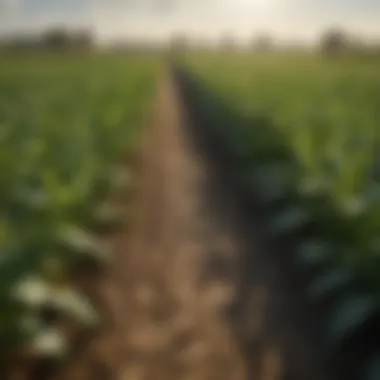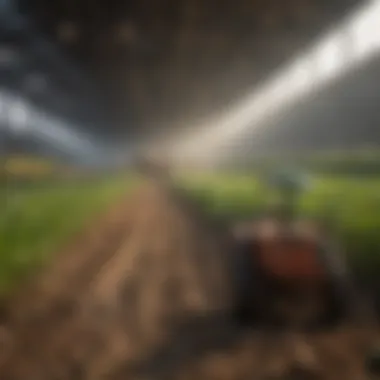Exploring Pricing Factors of Revytek Fungicide


Intro
The world of agriculture is constantly evolving, shaped by the myriad factors influencing crop production, pest management, and soil health. Among various tools available to farmers, fungicides play a vital role in protecting crops from fungal diseases. One such product that has gained significant attention is Revytek fungicide. Understanding the pricing dynamics of Revytek is essential for farmers and agronomists aiming to maximize crop yields while managing costs effectively.
In this article, we will delve into the pricing factors surrounding Revytek fungicide, assessing how demand shifts, regional availability, and production expenses create a complex web of influences. By examining these elements, readers will gain insights that facilitate informed purchasing decisions and enhance their overall crop management strategies.
Preamble to Revytek Fungicide
Fungicides play a pivotal role in modern agriculture, addressing the ever-present threat posed by fungal diseases. Among the choices available, Revytek fungicide stands out due to its specialized composition and effectiveness. Understanding the implications of using Revytek is crucial for farmers pursuing optimal crop health and yield. This section aims to shed light on the significance of Revytek fungicide in agricultural practices, including its active ingredients and overall purpose.
Overview of its Active Ingredients
At the heart of Revytek fungicide lies its unique blend of active ingredients designed to tackle a variety of fungal pathogens. The primary components, mefentrifluconazole and acibenzolar-S-methyl, work synergistically to inhibit fungal growth while also triggering plant defenses. They are selectively effective, acting against a range of leaf spots and blights that threaten key crops such as corn and soybeans.
The effectiveness of a fungicide often hinges on its formulation. Revytek is produced with advanced technologies that enhance the absorption of the active ingredients, allowing for quicker action against infections. By breaking down the modes of action, farmers can understand how and why Revytek can be a beneficial addition to their crop management strategies.
Purpose and Use in Agriculture
The purpose of Revytek fungicide extends well beyond just controlling fungal diseases. Its use highlights a commitment to sustainability in farming practices. By applying Revytek, farmers are equipping their crops with a protective shield that reduces loss and enhances productivity.
- Disease Prevention: Regular application helps in preventing outbreaks before they can take hold, ultimately safeguarding yield.
- Promoting Plant Health: By boosting innate plant defenses, Revytek supports healthier plants that can better withstand environmental stressors.
- Maximizing Yield Potential: Healthier, disease-free plants often translate to higher yields, directly impacting a farmer's bottom line.
Overall, Revytek fungicide not only aims to address immediate fungal threats but also fosters a longer-term vision for sustainable farming practices. As farmers increasingly navigate complex economic landscapes, tools like Revytek become essential assets in their agricultural toolbox.
Factors Influencing Revytek Fungicide Pricing
Understanding the various elements that dictate the pricing of Revytek fungicide is crucial for farmers and agricultural stakeholders. Prices don’t merely reflect the product's quality; they encompass a dynamic interplay of multiple factors. Knowing these aspects can aid in better decision-making, ultimately leading to more cost-effective crop management.
Raw Material Costs
Raw materials are the backbone of any production process, and Revytek fungicide is no exception. The price of the active ingredients and supporting components play a significant role in determining the final cost. For instance, if a particular raw material becomes scarce due to natural disasters or geopolitical issues, its price can soar. This change, in turn, pushes the cost of Revytek higher, affecting accessibility for farmers.
- Supply Chains: Keeping an eye on the supply chain stability helps in estimating potential price movements. An interruption in supply can drastically affect production schedules and cost estimates.
- Sourcing: Procurement practices also matter. If producers choose to source materials from less costly regions, it might save money, but could also involve risks like quality issues or longer shipping times that can impact overall pricing.
Production and Distribution Expenses
Once the raw materials are secured, the next layer influencing pricing involves production and distribution expenses. The complexities of manufacturing Revytek fungicide include labor costs, energy expenses, and manufacturing efficiencies.
- Fixed and Variable Costs: Understanding the difference between fixed (rent, salaries) and variable (utilities, raw materials) costs can clarify how production scaling can affect prices. In a competitive landscape, high fixed costs may compel manufacturers to keep prices elevated even when demand is lower.
- Transportation: Costs associated with moving the product from manufacturing plants to end users also factor in. If transport costs spike due to rising fuel prices, this will inevitably translate to higher final prices for the consumers.
"An increase in production costs often leads to a ripple effect in the agriculture sector, which can significantly burden farmers."
Market Demand and Supply Principles


When it comes to market dynamics, the law of supply and demand is a critical lens through which to view pricing. If the demand for fungicides spikes due to increased pest pressures or disease outbreaks, manufacturers may raise prices to balance demand with limited supply.
- Seasonal Variations: In agriculture, prices might fluctuate seasonally. For instance, prices could surge during planting seasons when demand hits a peak compared to off-seasons when farmers are less active.
- Substitutes: If farmers have access to alternative products, this competition can lead to price adjustments. Monitoring how similar fungicides like Revystar or Luna View perform in the market provides insight into what influences customers in making their choices.
Regulatory Influences
Agricultural regulations play a pivotal role in determining the price of fungicides. Compliance with safety and environmental standards often results in increased production costs. Regulatory changes might impose stricter guidelines, which demand additional investments in compliance and therefore escalate prices.
- Labeling Requirements: New regulations around product labeling can entail more costs for producers, which ultimately affects pricing structures.
- Environmental Policies: Stricter environmental laws regarding the use of chemicals may also restrict supply, thus driving up prices. A farmer must be aware of these factors to better predict their purchasing costs.
Market Analysis of Revytek Fungicide
Analyzing the market for Revytek fungicide is akin to peering into a complex puzzle that reveals various factors intertwining in agricultural practices. It's important because it sheds light on where the product stands in the competitive arena, how it fares against similar alternatives, and the conditions that lead to price fluctuations. For farmers and agronomists, knowing these dynamics can directly influence purchasing decisions and ultimately, yield outcomes.
Competitive Landscape
The competitive landscape for Revytek fungicide is dynamic, featuring a host of stakeholders ranging from manufacturers to wholesalers to farmers themselves. Several players comprise this arena, each offering alternative products with varying effectiveness, safety profiles, and costs.
For instance, products like Priaxor and Stratego YLD are notable competitors that target similar pathogens. Understanding how Revytek positions itself against these alternatives is crucial for farmers evaluating their options. Here, several points come into play:
- Efficacy: Does Revytek offer superior performance against diseases like gray leaf spot or white mold?
- Cost-effectiveness: How does Revytek’s pricing measure up to competitors when considering the return on investment in crop yield?
- Brand loyalty: Are farmers more inclined to trust established brands with a proven track record, or are they willing to try newer, potentially less familiar options?
By examining these elements, one can better grasp where Revytek fits in the marketplace and how that may impact its pricing strategies.
Price Comparisons with Similar Products
Diving into price comparisons reveals the intricate balance between cost and benefit. Revytek generally has a competitive pricing structure, which is essential for farmers faced with tight margins.
When comparing prices among fungicides, farmers might notice:
- Bulk Purchase Discounts: Many suppliers offer discounts for bulk purchases. This can lessen costs per acre if farmers buy strategically.
- Regional Pricing Differences: Prices can vary significantly based on location, reflecting supply chain dynamics and local competition.
- Promotions and Deals: Certain times of the year may see seasonal promotions, potentially affecting cost outlay significantly.
On a surface level, comparing dollar figures might seem straightforward, but digging into factors like unique benefits or novel usage patterns can elevate the analysis further.
Regional Price Variability
Regional price variability speaks to how location can shape the cost of Revytek fungicide. This variability stems from countless factors, including supply routes, local regulations, and prevailing climate issues.
For example:
- Transport Costs: Areas further from production facilities typically incur higher shipping charges, which will influence final pricing.
- Local Demand and Supply: High demand in certain regions may create upward price pressure, while oversupply can lead to discounts to entice buyers.
- Climate Impacts: Regions experiencing pest outbreaks or unique weather conditions may see a sharper rise in fungicide demand, impacting price dynamics.
Collectively, these elements underline the complex web of factors impacting pricing. Understanding regional price variability allows farmers to plan purchases more strategically, negotiating better deals based on timely insights.
"In the world of agriculture, knowledge translates to power; knowing the market intricacies can make a significant difference in financial outcomes."


Purchasing Considerations for Farmers
When it comes to selecting fungicides, farmers face an array of choices that could make or break an entire growing season. Revytek fungicide, with its unique combination of ingredients, offers benefits that can sway purchasing decisions. Understanding various purchasing considerations is crucial for making informed decisions that align with one's specific agricultural needs. This section highlights the significance of weighing price against effectiveness, the value of volume pricing, and the role of distributor relationships.
Evaluating Price vs. Effectiveness
In the agricultural realm, farmers often find themselves walking a tightrope between cost and efficacy. When evaluating Revytek, it's vital to recognize that a lower price doesn't always equate to a better deal in the long run. Effectiveness plays an instrumental role in determining overall value.
- Performance Metrics: Rely on field data and performance metrics to assess how well Revytek tackles common fungal challenges. Comparing these figures with other fungicides can provide vital insights into its true worth.
- Long-Term Benefits: Evaluate not just immediate outcomes but also long-term repercussions on crop yield and health. Investing slightly more upfront can lead to significantly higher returns later on.
- User Testimonials: Gathering feedback from fellow farmers can provide real-world insights. Engaging with community discussions on platforms like reddit.com may yield valuable anecdotal evidence concerning effectiveness.
Volume Pricing and Buying Strategies
Buying in bulk is not just about saving money; it’s a strategic method that can impact farming operations profoundly. Volume pricing can lead to substantial savings over time.
- Evaluate Needs: Assess how much product will be necessary for the season. This requires a comprehensive understanding of your lands’ specific issues and treatment requirements.
- Group Purchasing: Collaborating with neighboring farms to buy collectively can substantially lower costs. Farmers can benefit from shared experiences and pooling resources.
- Loyalty Programs: Some distributors offer loyalty incentives for bulk purchases, allowing for further cost reduction. Engage with these programs wherever possible to maximize benefits.
Distributor Relationships
Building a relationship with a reliable distributor can yield more than just access to products. Such relationships can also foster knowledge exchange and support when problems arise.
- Reliability: Choose distributors with proven track records. Not all distributors offer the same level of service and support, and having a go-to source can make all the difference during peak season.
- Technical Assistance: Many distributors provide expertise in product application or pest management strategies. Leveraging their knowledge can assist in achieving optimal results with Revytek.
- Communication Channel: Maintain an open line of communication with your distributor. Discussing needs openly can not only enhance your purchasing experience but may also allow for negotiated prices or exclusive deals.
During the assessment stage, consider both your short-term budget and your long-term agricultural conditions when making decisions about fungicides like Revytek.
Impact of Revytek Price on Agricultural Practices
The price of Revytek fungicide plays a significant role in shaping agricultural practices, influencing not just which products farmers choose, but also their overall yield and profitability. Understanding this intricate relationship can help farmers make informed choices regarding pest management and crop health.
Cost-Benefit Analysis for Farmers
When farmers consider using Revytek, they must conduct a thorough cost-benefit analysis. This process is not merely about comparing the price of the fungicide against their operational budget; it encompasses a broader evaluation of potential gains.
Farmers often ask:
- What are the potential yield increases from using Revytek? The goal is to assess how much more crop can be harvested if the fungicide is applied, balanced against the investment cost.
- How does Revytek perform compared to cheaper alternatives? Sometimes, a lower-priced option may not deliver the same effectiveness, leading to diminished results and, ultimately, lower income. Hence, it is crucial to analyze not only immediate expenses but also long-term benefits.
- What effect does Revytek have on the overall health of the crops? Healthier plants lead to better overall productivity and reduced losses.
The financial implications can be substantial. A successful application of Revytek could mean the difference between a bountiful harvest or a crop plagued by pests and disease. Farmers, therefore, must weigh these factors carefully, considering their specific agricultural context.
Connection Between Budgeting and Productivity
In the world of farming, budgeting isn't just a mere task—it is a focal point that determines ultimately how productive a farm can be. The relationship between a farmer's budget and the productivity of their land is tightly woven.
- The price of Revytek directly influences how much a farmer is willing to allocate from their budget for fungicide use. Higher prices might lead to budget cuts elsewhere or less frequent applications.
- Farmer’s productivity can fluctuate based on these budgetary decisions. For instance, if a farmer opts not to use Revytek due to its price, they may put themselves at risk of crop disease, which could result in a lower yield.
It's crucial, therefore, for farmers to consider how they budget for fungicides like Revytek. Effective budgeting can lead to improved productivity, whereas short-sighted cost-cutting can result in long-term consequences that affect both yields and farm viability.


"Every dollar spent on effective pest control can yield several in return, but only if that dollar is spent wisely."
Navigating the price of Revytek in relation to their farming budget ultimately shapes a farmer's strategy for crop management and helps them make choices that align with their production goals.
Future Trends in Fungicide Pricing
Understanding the future trends in fungicide pricing is crucial for farmers and agronomists navigating a landscape marked by constant changes. As advancements continue to unfold in technology and sustainability, these trends will impact not just prices, but the overall efficiency and effectiveness of agricultural practices. Keeping an eye on these developments can guide decision-making, shaping investment strategies and farm management approaches for the better.
Emerging Technologies and Their Effects
The role of technology in agriculture has surged, and that includes fungicide application. Innovations such as precision agriculture tools are beginning to change the game when it comes to fungicide efficacy and distribution costs. For instance, more farmers are using drone technology to target specific areas of their fields that show signs of fungal infection, rather than applying chemicals uniformly. This targeted approach can reduce overall fungicide use, leading to potential savings and lower farmer costs.
Another noteworthy trend is the development of biopesticides, derived from natural materials. These products often come at a higher initial investment but can yield long-term savings by reducing dependency on conventional fungicides. With environmental regulations tightening, emerging technologies are playing a pivotal role in making fungicides safer and more sustainable.
"Technological advancements are making fungicide applications more efficient, allowing farmers to save both money and resources while maintaining healthy crops."
Sustainability Initiatives and Costs
The agriculture sector is increasingly prioritizing sustainability, not just for ethical reasons but also due to consumer demand. Many farmers are adopting practices that minimize chemical residue and prioritize soil health. As a result, there’s a growing interest in sustainable fungicide options, which may initially cost more but often lead to better returns in the long run.
For example, practices such as crop rotation and integrated pest management can reduce the need for frequent fungicide applications. These initiatives encourage a healthy ecosystem in the field, thereby potentially reducing long-term operational costs. However, the initial investments in training and alternative cropping may deter some farmers. The balance between immediate costs and future savings will play a crucial role in shaping whether these sustainable practices become widespread.
Market Predictions and Projections
Looking ahead, market predictions suggest that fungicide pricing may be influenced by several factors. First, ongoing shifts in consumer behavior, with an emphasis on organic products, might compel manufacturers to reassess their pricing structures. As consumer awareness grows regarding chemical inputs, prices of traditional synthetic fungicides could face downward pressure.
Second, global supply chain issues have shown how interconnected modern agriculture is. Events affecting one part of the world can ripple through markets, impacting delivery times and costs. Projections also indicate that the climate will continue to play a significant role, as changing weather patterns can affect pest and disease prevalence, ultimately influencing fungicide demand.
Farmers should stay abreast of these market trends and be prepared to adapt. Awareness and flexibility in adopting new practices, technologies, and even farm business models will be paramount as the fungicide landscape evolves.
Ending
In this final section, it’s crucial to underline the essence of understanding the pricing dynamics associated with Revytek fungicide. This topic is not merely about the dollars and cents, but it dives into a broader landscape that affects agricultural practices and crop management strategies.
Recap of Key Insights
To encapsulate the key insights discussed throughout the article:
- Pricing Influencers: It is essential to recognize that various factors influence the prices of Revytek, including raw material costs and market demand. Understanding these factors can help farmers assess when to purchase and how much to budget.
- Competitiveness: The competitive landscape shows how Revytek compares to similar products, allowing farmers to make informed choices that might not always lean towards the lowest price.
- Regional Variability: Prices can fluctuate based on geographic availability and distribution networks, suggesting that farmers need to keep an eye on local markets.
- Future Trends: Innovations and sustainability efforts are reshaping the market dynamics, impacting long-term pricing structures.
These insights highlight that the economic aspect of fungicide pricing is complex and multifaceted, serving as a reminder of the careful balance needed in agricultural investments.
Final Thoughts on Agricultural Investments
As we wrap this up, it becomes evident that investments in fungicides like Revytek are not just transactional; they hold significant weight for future agricultural productivity. The decisions farmers make today regarding fungicide purchases can have lasting effects not only on crop yield but also on financial viability.
Choosing the right time to purchase Revytek based on market conditions or negotiating with distributors can yield substantial benefits. The financial health of farming operations often hinges on these seemingly small decisions. Therefore, as farmers navigate this intricate landscape, staying informed and adaptable is not just recommended; it is vital for long-term success.
"In farming, every dollar spent wisely today is an investment in tomorrow's harvest."
In sum, understanding Revytek fungicide pricing equips farmers and agronomists with the necessary tools to bolster their agricultural practices, all while ensuring they can compete effectively in an ever-evolving market.



